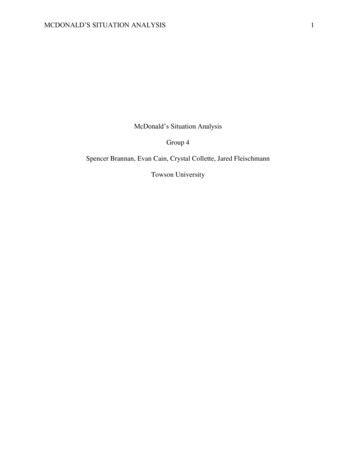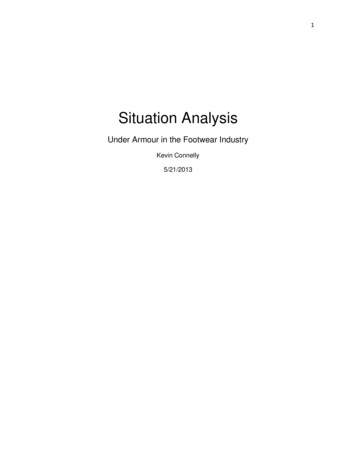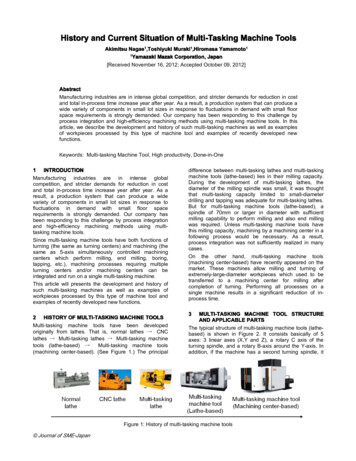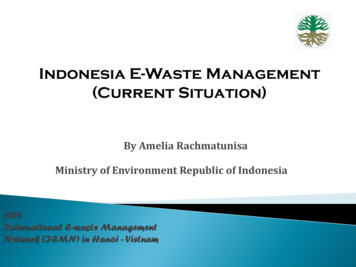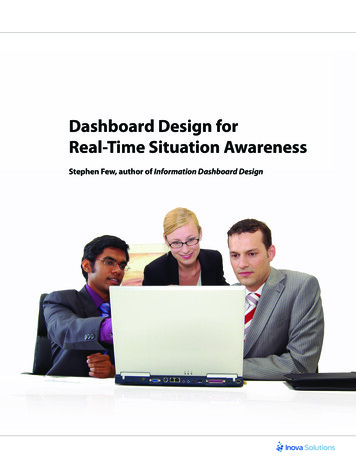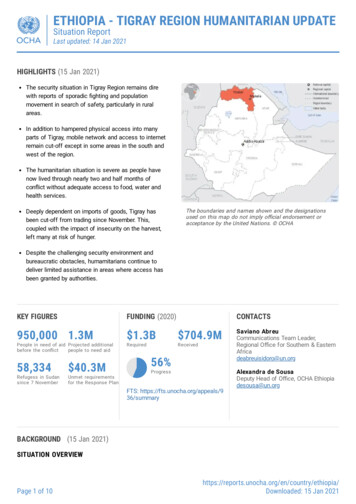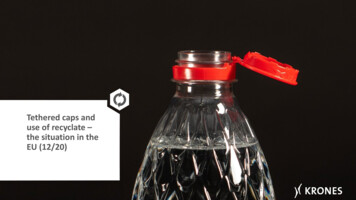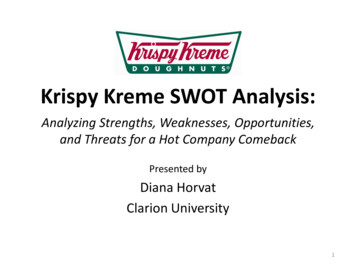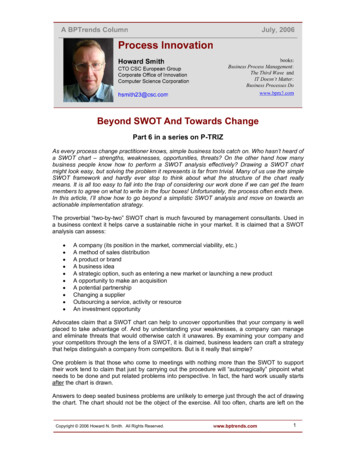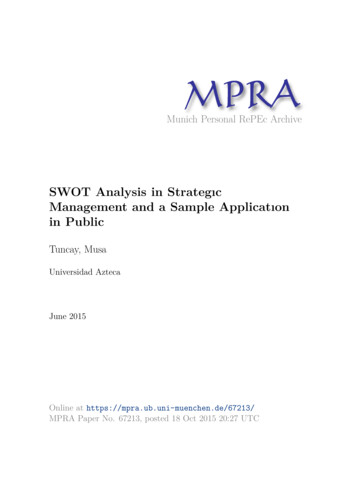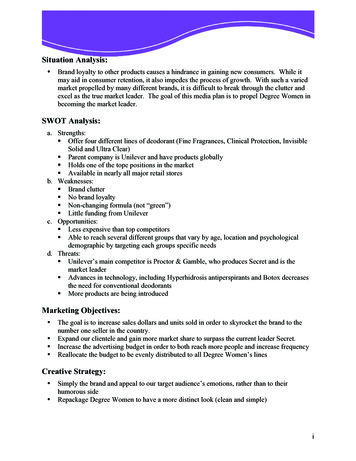
Transcription
Situation Analysis: Brand loyalty to other products causes a hindrance in gaining new consumers. While itmay aid in consumer retention, it also impedes the process of growth. With such a variedmarket propelled by many different brands, it is difficult to break through the clutter andexcel as the true market leader. The goal of this media plan is to propel Degree Women inbecoming the market leader.SWOT Analysis:a. Strengths: Offer four different lines of deodorant (Fine Fragrances, Clinical Protection, InvisibleSolid and Ultra Clear) Parent company is Unilever and have products globally Holds one of the tope positions in the market Available in nearly all major retail storesb. Weaknesses: Brand clutter No brand loyalty Non-changing formula (not “green”) Little funding from Unileverc. Opportunities: Less expensive than top competitors Able to reach several different groups that vary by age, location and psychologicaldemographic by targeting each groups specific needsd. Threats: Unilever’s main competitor is Proctor & Gamble, who produces Secret and is themarket leader Advances in technology, including Hyperhidrosis antiperspirants and Botox decreasesthe need for conventional deodorants More products are being introducedMarketing Objectives: The goal is to increase sales dollars and units sold in order to skyrocket the brand to thenumber one seller in the country.Expand our clientele and gain more market share to surpass the current leader Secret.Increase the advertising budget in order to both reach more people and increase frequencyReallocate the budget to be evenly distributed to all Degree Women’s linesCreative Strategy: Simply the brand and appeal to our target audience’s emotions, rather than to theirhumorous sideRepackage Degree Women to have a more distinct look (clean and simple)i
Print Ads – focus mainly on introducing the new look of the product with its femininetouchTelevision Ads – focus on the chaotic lives of women, showing the importance that noteverything needs to be stressful, including their deodorantIMCs – place Degree Women vending machines in college and gym locker rooms,women’s dorm bathrooms on college campuses and in nightclub bathrooms.Media Objectives:b. Target Coverage Reach 65 percent of our primary target audience an average of six times per month inthe introductory period of February – May, and maintain a reach of 45 percent of theprimary target audience an average of three times per month following the introductoryperiod. Our primary target audience of women between the ages of 25 and 49, have analready established disposable income. These women are single, have no children andlive in the Midwest and the Southern regions. This will be obtained through the use ofdifferent media types and vehicles geared toward our primary target audience. Reach 40 percent of our secondary target audience an average of four times per monthin the introductory period of February – May, and maintain a reach of 25 percent of theprimary target audience an average of two times per month following the introductoryperiod. Our secondary target audience is also women, but between the ages of 18 and24. These women live along the coastal cities, especially along the East Coast. Theyare mostly single, which is a reflection of the young age group. This will be obtainedthrough the use of different media types and vehicles geared toward our secondaryaudience.c. Overall Media Budget Current media budget for Degree Women is 22.1 million. This budget is allocatedtowards the Degree Ultra Clear deodorant line, and ignores the two other DegreeWomen lines. We want to increase the current overall media budget to 30 million andredistribute it evenly among all three Degree Women deodorant lines: Ultra Clear,Invisible Solid and Clinical Protection. By promoting all three women’s lines evenly, this can establish brand awareness andstrengthen the brand as a whole. This can also promote novelty for Degree, lettingpeople know that there are different lines and scents and that Degree is not just plainold deodorant.d. Seasonality & Regionality Seasonality – advertising seasons for Degree Women are separated into three differentseasons and are broken up into February – May, June – August and September –January. The budget will be allocated more heavily in the months of February – Mayand June – August. We plan to assign 68 percent of the overall budget in February –May, 18 percent of the budget in June – August and 14 percent of the budget inSeptember – January. Regionality – Degree is used more frequently in the Midwest and the South. We planto focus 60 percent of the 30 million of our advertising budget for television andmagazine advertisements and promotional pieces and integrated marketing in theMidwest and Southern regions. We will also advertise in the West and Northeast, butonly allocate 20 percent of the budget in each region.iiii
Media Strategy:a. Reach, Frequency, Media Weight Reach – 65 percent of the primary target audience Frequency – an average of six times per month Media Weight – the budget will be allocated roughly 90 percent toward television and10 percent toward magazine. This is caused mainly because of cost of each media.b. Scheduling We recommend a pulsing scheduling pattern because deodorant is a universally usedproduct and used year round, but it is used more often in the spring and summer monthswhen the weather is warmer.c. Suggestions for Vehicle Selection Network Television:i. Daytime; Early News; Prime Time; Late Night/Late News Cable Television:i. Daytime; Early Fringe; Prime Time; Late Fringe Syndicated Television:i. National Syndication Magazines:i. Women’s Interestd. Media Mix Network Television – 14, 236, 000 Cable Television – 5,556,900 Syndicated Television – 3,000,900 Magazines – 2,935,200Evaluation of the plan Our group feels that this media plan is the best suggestion for Degree Women based on ourresearch of the market, product and brand.iii
MC 4034Alex BoutteMeredith PursellBrad RichardBen West
Table of ContentsMarketing Problem 1Product/Brand Analysis 1Competitor’s Analysis 2Advertising Expenditure Analysis 3-6Share of Voice By Media 4Media Mix 5Market Share of Voice 6Market Share 6Product Life Cycle 7SWOT Analysis 7-9Marketing Objectives 10Marketing Mix 10Target Selection 11Media Objective 12-14Target Coverage 12Overall Media Budget 13Regionality 13Seasonality 14Media Strategy/Tactics 14-20Frequency and Reach 14Scheduling 15Budget Recap 16Media (types/vehicles) Selection and Rationale 17-18Media Mix 18-20Creative Strategy: How and What To Say 21IMC Efforts or Other Promotion Supports 21Copy Test 22
Marketing ProblemBrand loyalty to other products causes a hindrance in gaining new consumers. While it may aid in consumerretention, it also impedes the process of growth. With such a varied market propelled by many different brands,it is difficult to break through the clutter and excel as the true market leader.Product/Brand AnalysisIn 1990 Helene Curtis Industries, Inc. introduced Degree antiperspirant/deodorant, at that time the company’s most successful new product launch. With a formula activated as body heat rises—and aided by a 50million advertising campaign—Degree quickly garnered a large share of the market, achieving the company’smarket share goal for the brand’s first year in only eight months. Degree was introduced initially as a unisexline that was based on body-heat activation technology. Degree quickly rose and commanded 5.5% of the 1.2billion market. Degree was introduced at a much lower price when compared to the top two brands at the time,Secret and Sure, both produced by Procter & Gamble. This allowed Degree to acquire a 16% sales growth;causing Secret to fall 2% and Sure to fall 5%, and causing both to slash prices just to compete.Degrees prices remained substantially more inexpensive compared its main competitors, allowing its marketshare to rise. On December 22, 1993, Helene Curtis Industries, Inc. selected a new advertising firm to handleits Degree line of antiperspirants. DDB Needham Worldwide in Chicago was chosen. On February 14, 1996,Helene Curtis Industries, Inc. agreed to merge with British-Dutch consumer-products giant Unilever P.L.C.,Degree’s current parent company.In 2007, Degree introduced a line of clinical protection of deodorants. Degree entered this product into analready established market, trying to compete with its already conventional competitors, such as Secret. Degreealso introduced two new women’s lines of deodorants. First there is the Ultra Clear line, which is “Little BlackDress approved.” It alleviates white marks on skin and clothes, while providing long lasting wetness and odorprotection. Scents include Pure Clean, Pure Satin and Pure Powder. The second is the Fine Fragrance Collection which was created along with world-renowned fragrance expert Ann Gottlieb, who inspired each scent as if1
it were a perfume. Scents include Sexy Intrigue, Classic Romance and Delicious Bliss.There has been no significant decline in the Degree line of deodorants over the years. Deodorants and antiperspirants will always be a necessity.Degree, according to their website, has “unique body-responsive technology that releases extra protectionwhen you need it the most. Designed to meet the different needs of men and women, Degree is a top-performing antiperspirant/deodorant that provides outstanding odor and wetness protection.” Degree for women is thesecond leading women’s brand in deodorant, second to Secret.Degree is a part of the Unilever brand. Unilever is a well established company with many brands. Degreeis a fairly low priced product compared to the competition. While Secret is the number one female brand, it ispriced slightly higher than Degree. The clinical protection solid is priced at 8.99, ultra clear is 4.29 and theregular Degree Women is 3.49. The product is distributed across the nation as well as in the UK, by the nameSure, and around the rest of the world as Rexona. Degree is distributed in all major stores such as Wal-Mart,Target, Walgreens, CVS, etc. It is advertised mostly with television and print.Competitor’s AnalysisOne of Degree’s main competitors is Secret, produced by Procter & Gamble. As a leader in the industry,Secret holds a market share of 6.23 percent, or 73.5 Million. While it may be the top selling deodorant inthe U.S., its average cost is 4.99; much more than Degree’s 3.49. Secret is sold in most major retailers anddrugstores.Secret relies heavily on magazine ads as well as television ads for their campaigns. They are able to stayafloat in these media because their parent company, Procter & Gamble has a giant ad budget.Degree’s other main competitor is Dove, also produced by Unilever. They hold a market share of 4.90 percent, or 57.8 Million. Dove’s prices average between 3.29 and 4.79 depending on which scent or formula.Like Degree and Secret, Dove is sold in all major drugstores and supermarkets.Dove also relies heavily on magazine ads as well as television ads. Their products are seen as a high quality alternative to ordinary deodorants. Because Dove is famous for skin care, they are able to hone in on a2
different segment than many other deodorant brands.A secondary competitor of Degree would be Baby Powder. It can serve the same purposes as deodorant,and is often used in place of antiperspirants. Baby powder is very inexpensive and has been around for a verylong time, so it is a well-known, versatile product.Advertising Expenditure AnalysisMedia SpendingSundayMagazine MagazineDegree MediaSpendingSecret MediaSpendingDove 89.64725126.91192632069.76243.616101 61218.8553447.72996.9677.17314725541623527213 9663.7 277920.340430.73
SOV by %67%49%62%55%63%15%4
Media 0%1%2%Outdoor0%0%0%NetworkTV42%31%41%Spot TV1%3%1%SyndicatedTV9%10%9%CableTV16%26%15%5
Market SOV(via media summation)Degree SOVSecret SOVDove SOV46%25%19%Market SOV(via Ad Summary)Degree SOVSecret SOVDove SOV62.63%10.45%7.17%Market ShareDegreeSecretDove31%8%7%6
Product Life CycleCurrently, Degree is in the Maturity level of its life cycle. The brand has been a leader in the market fornearly 20 years, and has introduced different product lines to appeal to multiple demographic groups. Degreehas made its way through the introduction and growth stages, reaching a peak in the industry. However, thecompany does not want to fall into decline; they hope to maintain growth and hold their title as an industryleader.Marketing StrategySWOT AnalysisStrengths: Degree has expanded their assortment of choices for women. Their brand now features 4 types of de-odorant, all made for women. These choices include Fine Fragrances, Clinical Protection, Invisible Solid, andUltra Clear. By offering different formulas and scents, Degree is able to reach out to a larger, more varied audience. Degree has designed their packaging for all of the products for women in a more aesthetically pleas-ing manner. By creating more festive and interesting packaging, they are able to set themselves apart from thecompetition. Unilever, Degree’s parent company, is a world-wide leader in many different product categories. Be-cause they have influence in so many different areas, they were able to expand Degree products around theglobe, offering an international audience to add to their success in North America. Degree is a leader in the deodorant market, and holds one of the top positions in the antiperspirant indus-try. As a result of being a top industry product, Degree is available in nea
Competitor’s Analysis One of Degree’s main competitors is Secret, produced by Procter & Gamble. As a leader in the industry, Secret holds a market share of 6.23 percent, or 73.5 Million. While it may be the top selling deodorant in the U.S., its average cost is 4.99; much more than Degree’s 3.49. Secret is sold in most major retailers and
